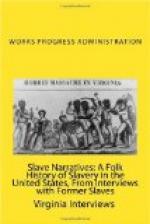One of Della’s grandmother’s favorite recipes was made of dried beef and wheat. The wheat was brought from the field and husked by hand. This, added to the rapidly boiling beef, was cooked until a mush resulted, which was then eaten from wooden bowls with spoons of the same material. White plates were never used by the slaves.
Cloth for clothing was woven on the place. Della’s grandmother did most of the spinning, and she taught her child to spin when she was so small that she had to stand on a raised plank to reach the wheel. After the cloth was spun it was dyed with dye made from “shoemake” (sumac) leaves, green walnuts, reeds, and copperas. One person cut and others sewed. The dresses for women were straight, like slips, and the garments of the small boys resembled night shirts. If desired, a bias fold of contrasting colour was placed at the waist line or at the bottom of dresses. The crudely made garments were starched with a solution of flour or meal and water which was strained and then boiled.
As a small child Della remembers hearing a peculiar knock on the door during the night, and a voice which replied to queries, “No one to hurt you, but keep that red flannel in your mouth. Have you plenty to eat? Don’t worry; you’ll be free.” No one would ever tell, if they knew, to whom this voice belonged.
Just before the beginning of the Civil War a comet appeared which was so bright that the elder people amused themselves by sitting on the rail fence and throwing pins upon the ground where the reflection was cast. The children scrambled madly to see who could find the most pins.
During the early part of the war Mr. Ross fought with the Confederates, leaving his young son, Robert, in charge of his affairs. The young master was very fond of horses and his favorite horse—“Bill”—was trained to do tricks. One of these was to lie down when tickled on his flanks. The Yankees visited the plantation and tried to take this horse. Robert, who loved him dearly, refused to dismount, and as they were about to shoot the horse beneath him, the slaves began to plead. They explained that the boy was kind to every one and devoted to animals, after which explanation, he was allowed to keep his horse.
The breastworks at Savannah required many laborers to complete their construction, and as the commanders desired to save the strength of their soldiers, slave labor was solicited. Two slaves from each nearby plantation were sent to work for a limited number of days. The round trip from the Ross plantation required seven days.
Nearly every man had a family and when they returned from these long trips they drove to the quarters and fell on their knees to receive the welcome caresses of their small children.
Recreational facilities were not provided and slave children had little knowledge of how to play. Their two main amusements were building frog houses and sliding down a steep bank on a long board. One day, as they played up and down the highway, building frog houses at irregular intervals, little Della looked up and saw a group of Yankee calvarymen approaching. She screamed and began running and so attracted the attention of Mr. Ross who was at home on a furlough.




